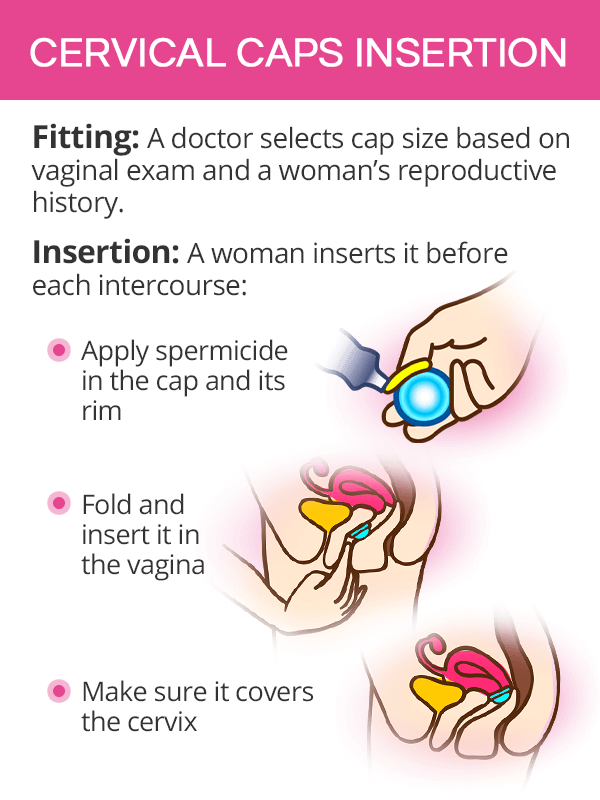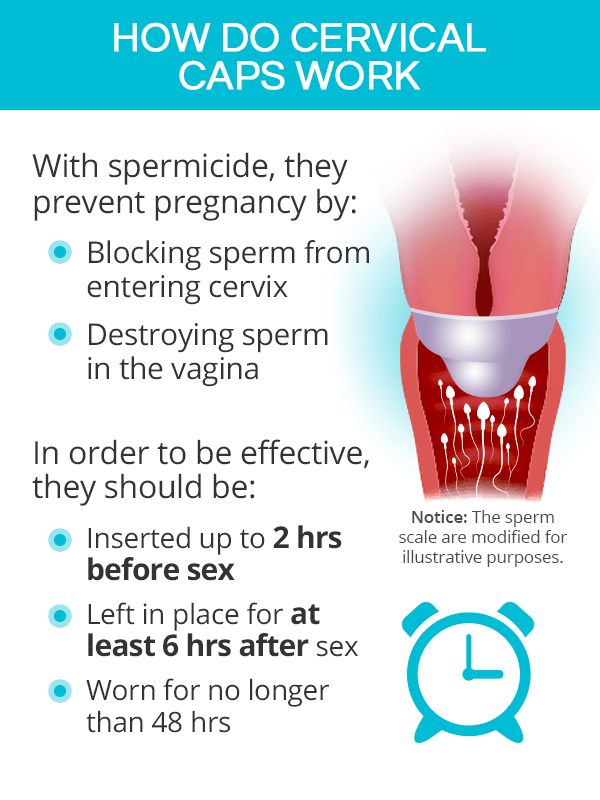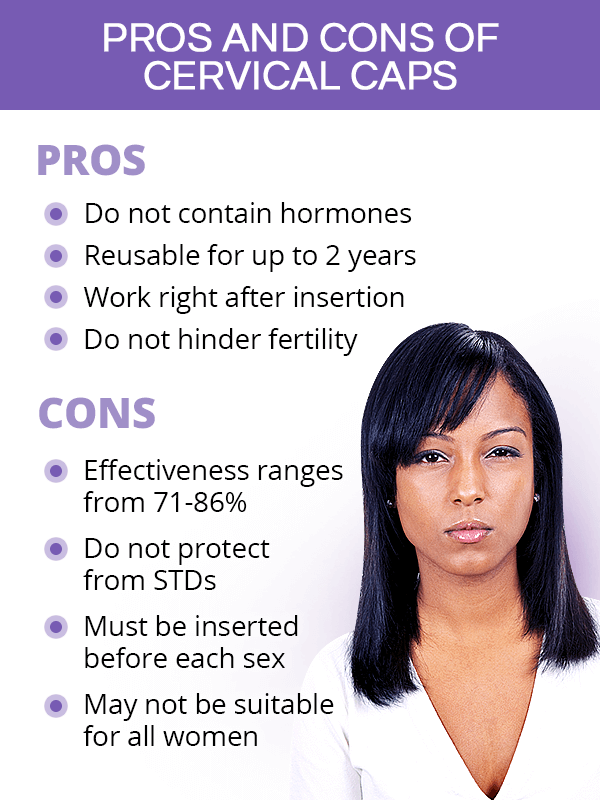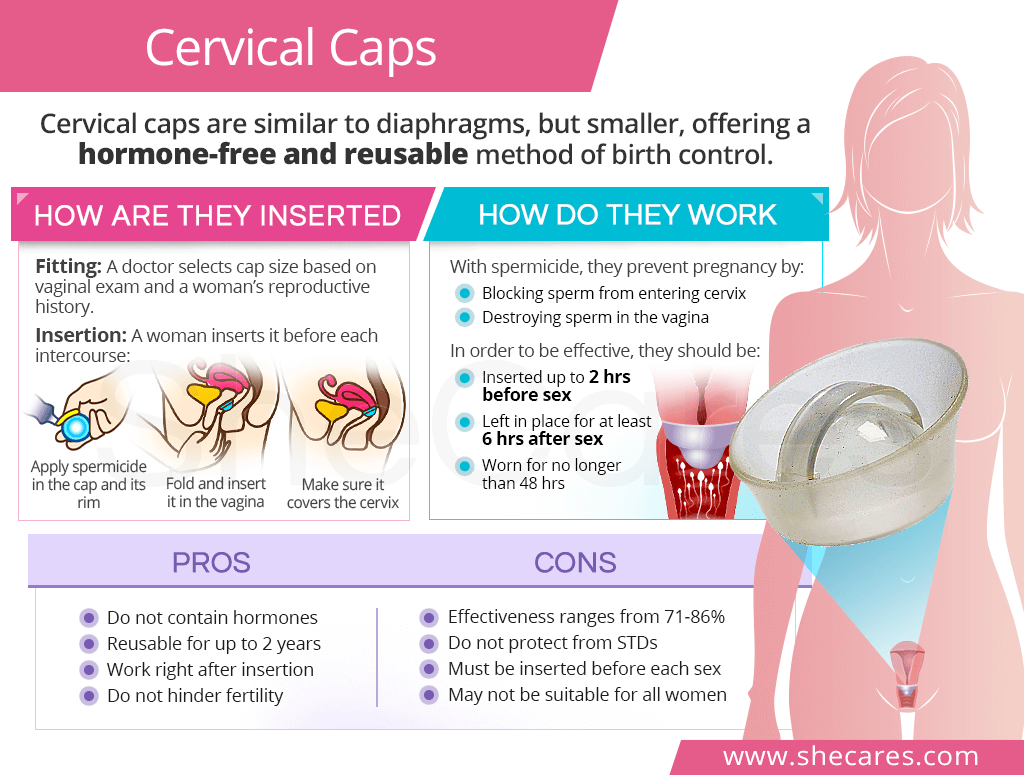What is a Cervical Cap?
A cervical cap is a small, silicone, reusable device that is inserted in the vagina to prevent pregnancy. It is shaped as a thimble with a little strap for easy removal. It does not contain hormones. Instead, it is used in combination with spermicide gel.
There is only one brand of cervical caps in the United States, called FemCapTM. It comes in three different sizes according to a woman's reproductive history.
While cervical caps can be purchased with a doctor's prescription, spermicides are available over the counter.
Cervical Cap Insertion

A cervical cap insertion at home is easy and straightforward, but has to be preceded by proper doctor's fitting to make sure it will provide the needed protection safely and consistently.
Cervical Cap Fitting
The objective of cervical cap fitting is to select the cap's size. This will be determined based on a vaginal examination and a woman's reproductive history. FemCap offers the following cap sizes:1
- Small (20mm): Women who have never been pregnant.
- Medium (26mm): Women who were pregnant, but did not deliver vaginally because of a miscarriage or a C-section.
- Large (30mm): Women who have given birth vaginally.
Cervical Cap Insertion & Removal
Once a woman has been fitted with the right cervical cap, she will insert and remove it on her own by following these instructions:2
- Inspect the cap for potential holes, wrinkles, and leaks.
- Apply about ¼ of a teaspoon of spermicide gel inside the cap's bowl and a thin layer on its rims.
- Apply about ½ of a teaspoon of the gel in the folded area between the rim and the dome.
- Squeeze the rim of the cap and slowly insert it so that its taller brim enters first.
- Push the cap deep into the vagina, making sure it covers the cervix.
The created suction will help keep the cap in place until a woman decides to remove it. She can do so by pushing up on the dome to break the seal, then hooking a finger under the strap and slowly taking it out of the vagina.
In between insertions, it is key to keep a cervical cap in hygienic conditions. Once taken out, the cap should be washed with soap and water, air dried, and stored in a designated container.
How do Cervical Caps Work

Similar to diaphragms, cervical caps should be inserted in the vagina every time a woman has sex.
The cervical cap prevents pregnancy by working as barrier. It blocks the sperm from passing through the cervix and up the reproductive tract. It is used in combination with spermicide gel, whose function is to kill the sperm
In order for a cervical cap to offer protection, it must be used as instructed, which includes the following:3
- A cervical cap should be inserted up to six hours before sex, preferably before sexual arousal.
- It must be left in place for at least six hours after sex.
- It can stay in place for up to 48 hours. Leaving it for longer may lead to toxic shock syndrome.
In case a woman has another intercourse while wearing a cervical cap, she should not remove the cap. Applying spermicide directly in the vagina should provide the needed protection. It is important to check instructions on the spermicide's package.
Pros and Cons of Cervical Caps

Cervical caps have been providing women with safe and reliable protection for years. However, they may not be the best option for all women.
Pros of Cervical Caps
- They are a cost-effective option as cervical caps can be reused for up to two years.4
- They work as soon as they are inserted and do not hinder fertility.
- Since they do not contain hormones, caps are suitable for women who do not or cannot take hormonal contraception.
- They do not contain latex, making them a safe option for women with latex allergies.
Cons of Cervical Caps
- For women who have never given birth vaginally, the caps are 86% effective.5
- For women who have given birth, they are 71% effective.5
- They do not protect against sexually transmitted diseases (STDs).
- They must be correctly be placed in the vagina every time a woman has sex.
- It should not be used during periods as it may lead to infections.
- Nonoxynol-9, a chemical found in most spermicides, has been linked to serious health risks.6
Key Takeaways
Women who opt out of using hormonal contraception due to personal preference or medical restrictions might benefit from giving cervical caps a try. They do not contain hormones, but in order to be effective, caps must be used along with spermicide. Before a woman can insert them by herself, she first has to be correctly fitted with one of the three available sizes. This will depend on whether she was pregnant and gave vaginal birth in the past. Cervical caps must be inserted each time a woman has sex, but can be left in place for longer than diaphragms (48 hours). It is key to take note that cervical cap effectiveness is lower for women who had vaginal deliveries, 71%, as opposed to those who never gave birth vaginally, 86%. They also do not protect against STDs. Nevertheless, they are a popular and convenient birth control option for thousands of women around the world.
Sources
- CDC. (2020). Contraception. Retrieved October 26, 2020 from https://www.cdc.gov/reproductivehealth/contraception/index.htm
- Harvard Health Publishing. (2020). Diaphragm, Cervical Cap, Sponge. Retrieved October 26, 2020 from https://www.health.harvard.edu/birth-control/methods/type/diaphragm-cervical-cap-sponge
- Medline Plus. (2020). Barrier methods of birth control – series - cervical cap. Retrieved October 26, 2020 from https://medlineplus.gov/ency/presentations/100107_3.htm
- Medline Plus. (2020). The cervical cap. Retrieved October 26, 2020 from https://medlineplus.gov/ency/imagepages/17033.htm
Footnotes:
- FemCap. (n.d.). Our products. Retrieved October 26, 2020 from https://femcap.com/new/
- Mayo Clinic. (2020). Cervical Cap. Retrieved October 26, 2020 from https://www.mayoclinic.org/tests-procedures/cervical-cap/about/pac-20393416
- American College of Obstetricians and Gynecologists. (2018). Barrier Methods of Birth Control Spermicide Condom Sponge Diaphragm and Cervical Cap. Retrieved October 26, 2020 from https://www.acog.org/womens-health/faqs/barrier-methods-of-birth-control-spermicide-condom-sponge-diaphragm-and-cervical-cap
- University of Michigan. (n.d.). Other Barrier Methods: Diaphragms, Cervical Caps and Sponges, plus Spermicide. Retrieved October 26, 2020 from https://uhs.umich.edu/contraception-other
- Teens Health. (2018). The Cervical Cap. Retrieved October 26, 2020 from https://kidshealth.org/en/teens/contraception-cap.html
- Planned Parenthood. (n.d.). Cervical Cap. Retrieved October 26, 2020 from https://www.plannedparenthood.org/learn/birth-control/cervical-cap
